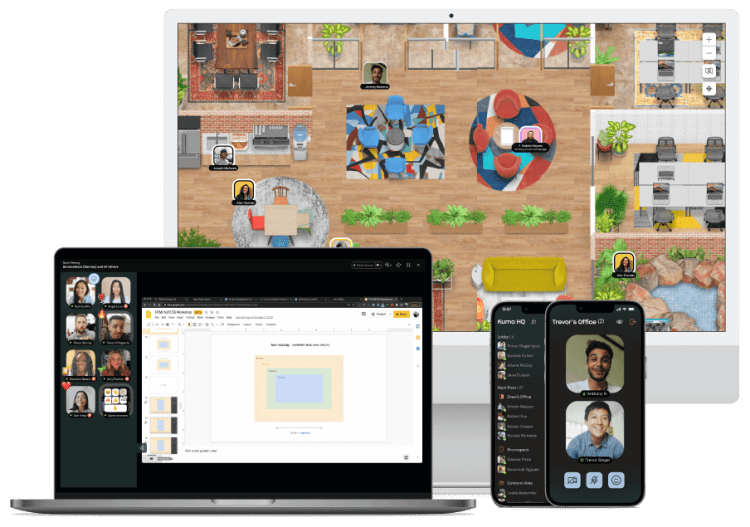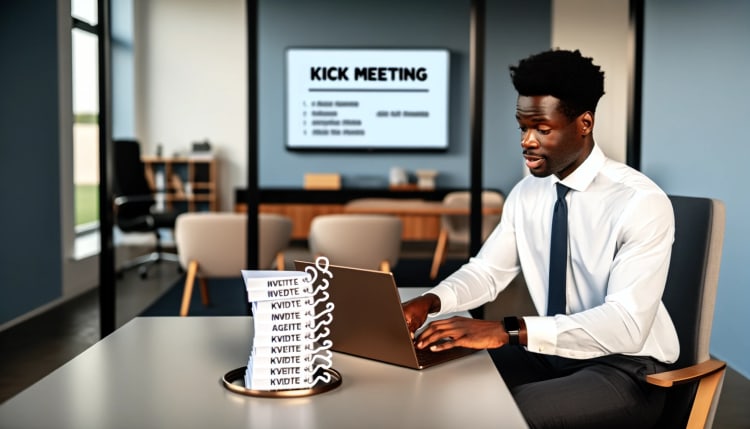Imagine starting your next project with a sense of excitement and confidence, knowing that your team is fully prepared, aligned, and motivated to achieve success. This can be a reality when you master the art of the kick off meeting. With the help of Kumospace, we’ll guide you through the strategies and tools needed for a dynamic project launch, setting the stage for a successful outcome.
Key takeaways
- A successful internal project kickoff meeting sets the tone, establishes goals and objectives, builds relationships and trust, identifies risks & challenges.
- Key components include introductions/icebreakers, overview of project background, scope/timeline/milestones discussions. Leveraging tools for engaging meetings.
- Pre-meeting preparation is essential as well as encouraging participation & post-meeting follow up to ensure a successful kickoff meeting & project completion.
The power of a kick off meeting

Effective project management hinges on a well-executed internal project kickoff meeting. This inaugural meeting marks the transition from planning to execution, bringing together the project manager, client, and team members. Kickoff meetings contribute to project success by:
- Setting the tone
- Building relationships
- Establishing goals
- Pinpointing potential risks at the start
Both key stakeholders and project team members gain from a well-defined project kickoff meeting agenda that ensures everyone works jointly towards a common goal, maintaining unity. A well-conducted kickoff meeting can lay a strong foundation for the project, thus enhancing the chances of its successful completion and increasing client satisfaction.
Establishing clear goals and objectives
During a project kickoff meeting, discussing project details ensures that everyone is on the same page and understands the project’s goals, scope, and timeline. By presenting the project purpose and mission statement, team members are informed of the client’s expectations and the impact their work will have on the end-users.
To further clarify roles and responsibilities, a RACI chart can be created, reducing uncertainties and providing a clear understanding of each team member’s contribution. Establishing expectations and setting the stage for collaboration, a well-prepared kickoff meeting agenda guarantees that the project begins on the right foot.
Building relationships and trust
Fostering trust and relationships during a kickoff meeting paves the way for a productive and cooperative work environment. Here are some steps to achieve this:
- Identify project stakeholders during the first meeting to ensure that all relevant parties are included and informed about the project’s progress.
- Review the project schedule to set clear expectations and deadlines.
- Encourage open communication among team members to promote collaboration and problem-solving.
- Actively listen to one another to show respect and understanding.
By following these steps, you can establish trust and rapport among team members, leading to a more successful project.
For virtual kickoff meetings, trust can be further cultivated with:
- Transparent communication
- Clear expectations
- Regular check-ins
- Virtual team building activities
- Set ground rules
A collective comprehension of the project’s scope, timeline, and milestones fosters unity and commitment among team members.
Identifying potential risks and challenges
Recognizing potential risks and challenges during a kickoff meeting paves the way for proactive planning and the development of mitigation strategies. Discussing the project scope helps team members raise questions about budgets and timelines, and re-evaluate whether objectives are attainable and feasible within project limitations.
Sharing the project timeline overview ensures that everyone is aware of deadlines and deliverables, preventing misunderstandings and promoting accountability. Risk management in project management involves analyzing potential risks and devising a plan to address them when needed.
Formulating a RACI or DACI matrix during the kickoff meeting aids in assigning roles and responsibilities, creating a pathway for project success.
Kick off meeting essentials: key components

A successful kick off meeting consists of several key components, including introductions, project overview, and discussions on the scope, timeline, and milestones. The project manager typically leads the meeting, ensuring that all necessary topics are addressed and that the meeting is organized and productive.
Establishing reciprocal communication during the kickoff meeting is vital for the sharing of perspectives and ideas. Disclosing the project plan during the meeting helps team members understand crucial details such as the project timeline, critical milestones, and essential deliverables. Note-taking during the meeting ensures that crucial information is recorded for future reference.
Introductions and icebreakers
Introductions and icebreakers are pivotal in kickoff meetings, fostering rapport and cultivating a conducive environment for collaboration. Inclusion of an icebreaker session during a kickoff meeting can facilitate quick rapport building among team members, promoting trust and mutual understanding.
Effective icebreaker activities for virtual kick off meetings include association introductions, “me too,” hot seat, and word tree. A well-planned icebreaker can facilitate strong relationships by constructing psychological safety, promoting collaboration, generating engagement, easing the atmosphere, and augmenting team cohesion.
Project overview and background
Offering an overview and background of the project guarantees that all stakeholders understand the project’s purpose. Essential information to be included in a project overview for a kick off meeting comprises:
- Project goals and objectives
- Project background
- Project scope
- Project timeline
- Roles and responsibilities
- Communication plan
- Risks and mitigation strategies
- Stakeholder expectations
- Resources and constraints
- Next steps
Comprehending the project background has several benefits:
- Boosts stakeholder engagement
- Provides a detailed understanding of the project’s aims, objectives, and scope
- Facilitates effective communication and collaboration
- Fosters trust and credibility with stakeholders
- Leads to an increased level of stakeholder support and dedication to the project’s success.
Scope, timeline, and milestones
Discussing the project scope, timeline, and milestones during a kick off meeting helps set expectations and keeps the project on track. Some essential elements for defining a project’s scope during a kick off meeting include:
- Providing a comprehensive description of the project work
- Engaging relevant stakeholders
- Establishing definite goals and tasks
- Allocating roles and responsibilities
- Presenting the project scope as a roadmap
By incorporating these elements, you can effectively define the scope of your project during a kick off meeting.
Clearly presenting the project timeline overview is paramount for the team, since they are responsible for meeting the deadlines and delivering the expected outcomes. Setting project milestones at the beginning assists in:
- Defining clear goals and objectives
- Monitoring progress
- Managing resources effectively
- Enhancing communication and collaboration
- Improving risk management.
Leveraging Kumospace for engaging kick off meetings

Kumospace provides the following features for engaging and effective kickoff meetings:
- Dynamic virtual spaces that mimic real-life interactions
- Agenda templates for structured meetings
- Real-time collaboration features for seamless teamwork
These features enhance engagement in remote kickoff meetings, enabling team members to connect and collaborate irrespective of their geographical locations.
Using Kumospace’s resources like project kickoff agenda templates can lead to a well-structured and productive meeting experience. Kumospace’s real-time collaboration features, such as screen sharing, team chat, and document sharing, facilitate smooth communication and teamwork during kickoff meetings, aiding teams in achieving project success.
Dynamic virtual spaces
Offering a unique and immersive experience, Kumospace’s dynamic virtual spaces simulate a physical office ambiance, encouraging collaboration among remote teams during kickoff meetings. By utilizing spatial audio technology and customizable virtual environments, Kumospace enables natural and immersive virtual interactions that closely resemble real-life experiences.
In addition, Kumospace provides features such as:
- Digital whiteboards
- Interactive displays
- Screen sharing tools
- Interactive features like polls and breakout rooms
These dynamic virtual spaces assist in creating a motivating and cooperative virtual environment that promotes efficient communication and collaboration during kick off meetings.
Agenda templates and resources
Kumospace offers resources and agenda templates to assist in planning and executing successful kickoff meetings. These templates guarantee that all relevant topics are addressed and that the meeting is kept organized and productive. By incorporating interactive components that can boost engagement during the meeting, such as acknowledging top performers or incorporating interactive activities, Kumospace aids in generating a vibrant and engaging kick off meeting experience for all attendees.
Customization options within Kumospace’s agenda templates allow users to tailor the templates to their specific requirements, ensuring that crucial details are covered and that the kick off meeting is tailored to the unique needs of the project. With these resources at hand, planning and conducting an effective kick off meeting becomes a streamlined and efficient process.
Real-time collaboration features
Kumospace’s real-time collaboration features enable smooth communication and teamwork during kickoff meetings. Some of these features include:
- A realistic virtual office layout
- Video and text chat
- A virtual whiteboard
- Screen sharing
- Document collaboration
- Real-time discussions
By offering these features, Kumospace ensures that project team members can effectively collaborate and communicate during the crucial initial stages of the project, setting the stage for success.
In addition to facilitating collaboration during the kick off meeting itself, Kumospace’s real-time collaboration features help maintain open communication channels throughout the entire project. This ongoing collaboration ensures that all team members are kept up-to-date and engaged in the project, ultimately contributing to the successful completion of the project.
Tips for conducting successful kick off meetings

Focusing on three key aspects - pre-meeting preparation, encouraging participation, and post-meeting follow-up, is vital to ensure a successful kickoff meeting. By investing time and effort in these areas, project managers can create an engaging and productive kick off meeting experience that sets the stage for project success.
Implementing these best practices, along with leveraging the power of Kumospace’s dynamic virtual spaces and real-time collaboration features, will ensure a well-executed kickoff meeting that effectively aligns the project team members and sets the stage for successful project completion.
Pre-meeting preparation
Pre-meeting preparation for a kickoff meeting involves formulating a clear agenda, finalizing the invite list, and designating a note taker. A well-prepared agenda ensures that all relevant topics are addressed during the meeting, keeping the discussion focused and organized.
In addition, determining the invite list before sending out the meeting invite ensures that all key stakeholders and decision-makers are included, reducing the risk of miscommunication or overlooked input.
Assigning a note taker to document the discussions and decisions made during the meeting is essential for future recollection and reference.
Encouraging participation
During the kickoff meeting, encouraging participation is important as it ensures everyone’s input is acknowledged, fostering a collaborative environment. This can be achieved by incorporating icebreakers or exercises to foster familiarity and rapport among participants, as well as having participants outline their contributions to the project and their outlook on the task.
Providing a clear invitation that outlines the goal of the meeting and provides a schedule can set expectations and foster an atmosphere of openness, trust, and engagement. By actively engaging all project team members, the kick off meeting creates a strong foundation for successful collaboration and project completion.
Post-meeting follow-up
A post-meeting follow-up is imperative to carry the momentum generated during the kickoff meeting forward into the project. This includes sharing meeting notes, assigning action items, and maintaining open communication channels between team members.
Sending a thank-you email, summarizing key points, disseminating action items and next steps, supplying additional resources, establishing clear expectations, presenting an opportunity for questions and feedback, and expressing gratitude are all important aspects of a successful post-meeting follow-up. These steps help reinforce the importance of the kick off meeting and ensure that all team members remain engaged and committed to the project’s success.
Real-world kick off meeting examples

Real-world examples of project kickoff meetings underscore the significance of a well-executed kickoff meeting in paving the way for project success. Companies across various industries have utilized kick off meetings to align project goals, build relationships, and identify potential risks, ultimately contributing to successful project outcomes.
Project managers can confidently steer their teams towards project success by adhering to the best practices outlined here and capitalizing on Kumospace’s capabilities for engaging virtual kickoff meetings, supported by the right project management software.
Summary
In conclusion, mastering the art of the kick off meeting is essential for setting the stage for project success. By focusing on establishing clear goals and objectives, building relationships and trust, identifying potential risks and challenges, and leveraging the power of Kumospace’s dynamic virtual spaces and real-time collaboration features, project managers can create an engaging and productive kick off meeting experience. Implement these best practices and watch your next project flourish.
Frequently asked questions
A project kick-off meeting is the first meeting with the project team and the client of the project, where applicable. The agenda for the meeting should introduce the project team and clarify roles and responsibilities, establish a shared understanding of the project's goal and objectives, and get buy-in from all stakeholders on the project plan.
Introduce the project and team members, discuss the project's background, goal, scope, timeline, roles, and next steps. Leave room for questions at the end.
The project manager is responsible for organizing the kickoff meeting. They usually conduct an internal meeting with the project team before holding an external meeting with clients and stakeholders, in which they discuss project plans, timelines, and background.
A kick off event is an activity or event that starts in a particular way, beginning the rest of the activities or events in the series. It marks the official start of the process.
To ensure effective participation during a kickoff meeting, use icebreakers to get attendees talking, foster an open atmosphere of communication, actively listen to each other's perspectives, and invite input from everyone.





